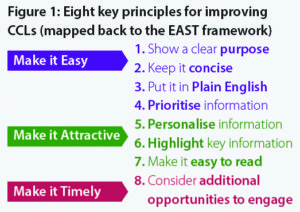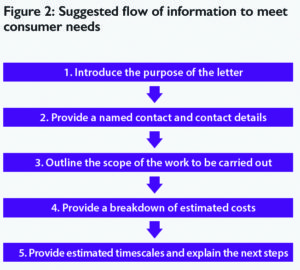 In the second of three articles concerning client care letters (CCLs), CILEx Regulation’s consumer engagement and policy officer, Sue Chandler, explains why CCLs are a great opportunity to win over your client.
In the second of three articles concerning client care letters (CCLs), CILEx Regulation’s consumer engagement and policy officer, Sue Chandler, explains why CCLs are a great opportunity to win over your client.
First impressions are hard to change, so it is vital to get right the first letter you send to your client, that is, the CCL. Unfortunately, too many CCLs fail to make the right impression with clients as research published in November 2016 confirmed.1
As a lawyer, you may frequently deal with documents which are pages long, have lengthy and wordy paragraphs, perhaps printed in small font, which contain legalistic words and phrases. But clients find CCLs impenetrable when they are presented in the same way. The problems are exacerbated for clients with a vulnerability. Vulnerability can be dynamic, and many people who may not ordinarily be vulnerable may become so due to their life circumstances. For example, during a property transaction resulting from job loss because of ill health.
The research provides eight key principles to follow when preparing a CCL (see Figure 1). This article focuses on principles 4 and 5 below.2

Principle 4: Prioritise information
Provide information relevant to a client’s specific case, rather than generic information, on the first page of the CCL.
Provide information that will enable your client to build an understanding of the legal processes they are to go through. During the research, consumers spontaneously identified that they need CCLs to answer the following questions:
- What is going to happen?
- How much is it going to cost?
- When is it going to happen?
- What do I have to do?
- How do I get in touch?
Place generic information, such as terms of business or the complaints procedure, later in the CCL. Interestingly, the researchers found that giving complaints procedures early prominence in a CCL can create a negative tone and suggest that something is likely to go wrong.
Avoid mixing generic information and case-specific information: doing this will make it easier for your client to navigate your CCL and pull out key information.
You need to structure your CCL to meet your client’s needs. If your letter has a logical structure, your client will find it easier to navigate through the content and be less likely to put the letter aside to read later – which may not happen. A suggested flow for a CCL is shown at Figure 2.

Principle 5: Personalise information
Keep it real! Clients are more likely to engage with information they feel is relevant to their individual circumstances. Your client’s perception that they are receiving a tailored service is central to them having a sense of satisfaction in the service you provide.
Avoid using largely generic information, including options that had already been ruled out at the first meeting or discussion, as this can make you seem uncaring and transactional. For example: ‘If you are an existing client and I have already established your identity and address, further evidence may not be necessary.’
Use your CCL to demonstrate to your client that you have knowledge and an understanding of their case. This enables you to:
- build your client’s confidence in you as their legal services provider; and
- make them feel valued.
Aim to use an opening sentence in your CCL because this will make the letter feel more personal and your client will feel more relaxed about the communication.
To develop more personalised CCLs, the following are important:
- Personalise information wherever possible. For example, provide realistic rather than vague estimates for likely timescales and costs.
- Use personal pronouns to make it clear the communication is between the person handling the case and the client. For example:’ I’, ‘you’, ‘we’ rather than ‘the defendant’.
- Consider the tone of your CCL and show empathy where appropriate. For example: ‘It was a pleasure to meet you last week, even under the difficult circumstances that brought you to me.’
Next steps
Why not try out our next steps?3
- How easy is it to engage with your CCL?
- Have you ever put it to the test?
- Why not ask a family member or friend to read through your letter and give feedback?
- How many tweaks will you make to your CCL this month to gain even better client satisfaction?
1 Research into Client Care Letters: qualitative research report, available here.
2 See ‘Client care letters: key principles’, (2017) March CILExJ pp38 and 39 to find out more about principles 1–3, available here.
3 See note 2, p39
To read the article in full click here.












